Fig. 34.1
Ultrasound imaging of the transversus abdominis (TrA, a) and multifidus (MF, b) with insertion of hypodermic needles
34.3 EMG Analysis of Trunk Mucles During Lumbar Stabilization Exercises
34.3.1 The Activity of the Trunk Muscles During Various Lumbar Stabilization Exercises
Bridge exercises, such as the elbow-toe, hand-knee, back bridge and side bridge exercise, are performed as basic lumbar stabilization exercises in clinics and are illustrated in Fig. 34.2. We measured EMG amplitudes during the ten lumbar stabilization exercises to determine if there were exercises that were more effective for the activation of local muscles. The elbow-toe with contralateral arm and left leg lift exercise significantly produced higher activity level for the TrA than did the other exercises (Fig. 34.3) (Okubo et al. 2010). The activity levels of the right TrA showed 41.8 ± 20.2 % of the maximum voluntary contraction (MVC) (mean ± SD) during the elbow-toe with right arm and left leg lift exercise, and activity levels of the left TrA showed 50.6 ± 28.4 % of the MVC during the elbow-toe with left arm and right leg lift exercise. For the MF, back bridge exercises and the hand-knee with contralateral arm and leg lift exercise produced significantly higher activity levels than did the other exercises (Fig. 34.4) (Okubo et al. 2010). In general, the results showed a tendency for the antigravity muscles facing the floor, such as the abdominal muscles, to have a greater activation during bridge exercises and during elbow-toe exercises. The back muscles were more active during back bridge exercises and the external oblique (EO) during side bridge exercises (Fig. 34.5).

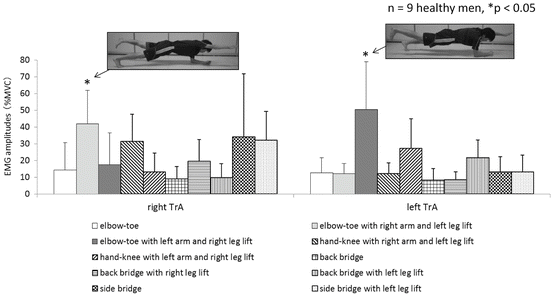
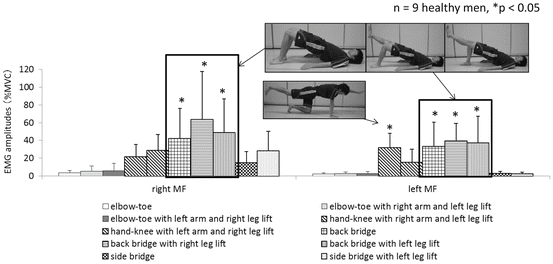
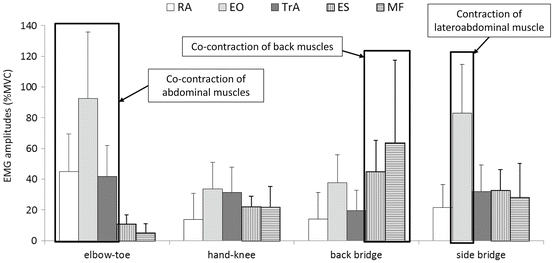

Fig. 34.2
Basic posture for each lumbar stabilization exercise

Fig. 34.3
EMG amplitudes of the tranversus abdominis (TrA) during each lumbar stabilization exercise

Fig. 34.4
EMG amplitudes of the multifidus (MF) during each lumbar stabilization exercise

Fig. 34.5
Activity pattern of trunk muscles for each lumbar stabilization exercise. RA rectus abdominis, EO external oblique, TrA transversus abdominis, ES erector spinae, MF multifidus
Additionally, we compared trunk muscle activity during three different prone bridge exercises, the elbow-toe, elbow-knee, and hand-knee exercises. These exercises all involve lifting of the contralateral arm and leg. The activity of the rectus abdominis (RA) and EO was significantly greater during the elbow-toe exercise than during the elbow-knee or hand-knee exercises. The activity of the erector spinae (ES) and MF was significantly greater during the hand-knee exercise than during the elbow-toe or elbow-knee exercises. It was remarkable that there was no significant difference in the activity of the TrA during the three exercises (Fig. 34.6) (Okubo et al. 2012). These results indicate that the elbow-toe exercise activated the superficial abdominal muscles, and the hand-knee exercises activated the back muscles. On the other hand, the TrA activity level remained similar during the different prone bridge exercises.
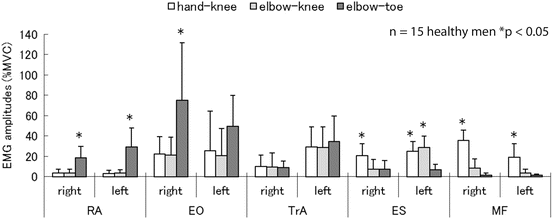

Fig. 34.6
EMG amplitudes during 3 prone bridge with left arm and right leg lift. RA rectus abdominis, EO external oblique, TrA transversus abdominis, ES erector spinae, MF multifidus
34.3.2 Changes in Trunk Muscle Activity by Lifting of the Extremities During Lumbar Stabilization Exercise
The lifting of the extremities during lumbar stabilization exercises is thought to enhance the deep trunk muscle contraction. We examined changes in trunk muscle activity elicited by lifting of the extremities during elbow-toe and hand-knee exercises. Activity in the left TrA was significantly greater during the elbow-toe exercise with the left arm lift. Moreover, in the lifted arm, activity of the TrA and contralateral EO increased significantly during the elbow-toe with contralateral arm and leg lift (Fig. 34.7) (Okubo et al. 2011). These results suggest that activity of the ipsilateral TrA and contralateral EO in the lifted arm increase during the elbow-toe with arm lift. Therefore, there is thought to be disfunction of the right TrA or the left EO if an athlete has difficulty in lifting the right arm during the elbow-toe exercise. During the hand-knee exercise, the left MF activity significantly increased with the left leg lift, while the activity of the MF in the lifted leg and contralateral ES was significantly greater with the contralateral arm and leg lift. These results suggest that trunk stability is enhanced by co-contraction of deep and superficial trunk muscles during elbow-toe and hand-knee exercises involving the contralateral arm and leg lift.
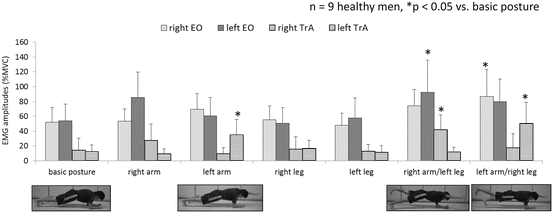

Fig. 34.7
Change in muscle activity by lifting up the extremities during elbow-toe exercise. EO external oblique, TrA transversus abdominis
34.3.3 Trunk Muscle Activity During Lumbar Stabilization Exercises on Stable and Unstable Surfaces
Lumbar stabilization exercises on an unstable surface are performed widely. However, there is little evidence in the literature as to whether performing lumbar stabilization exercises on an unstable surface actually increases muscular demand. To evaluate the value of this exercise, we compared muscle activity for hand-knee and back bridge exercises between stable and unstable conditions. The activity of the RA, EO, and ES during hand-knee exercise was significantly greater when performed on an unstable surface as compared to a stable surface (Fig. 34.8) (Imai et al. 2010). With the side bridge exercise, only activity of the RA was significantly greater in the unstable condition (Fig. 34.9) (Imai et al. 2010). These results indicate that activity of the global muscles, such as that in the RA and EO, is greater when lumbar stabilization exercises are performed on an unstable surface.










